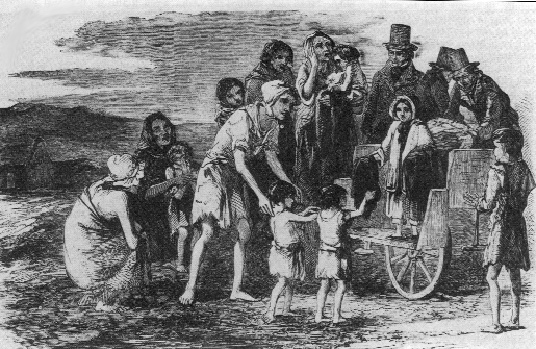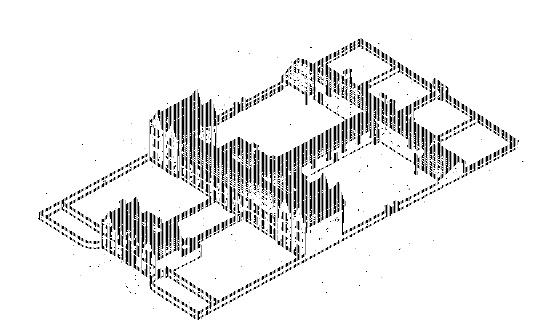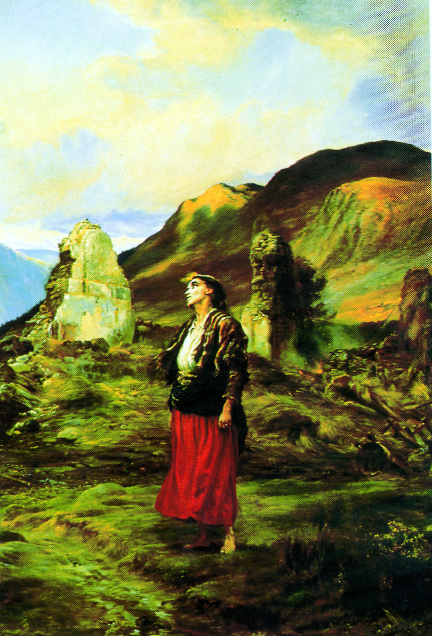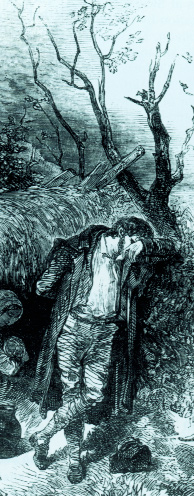A sexual revolution in the west of Ireland?
Published in 18th-19th Century Social Perspectives, 18th–19th - Century History, Features, Issue 6 (Nov/Dec 2006), The Famine, Volume 14
Miss Kennedy, seven-year-old daughter of Capt. Kennedy, Poor Law inspector of the Kilrush Union, distributing clothing to the destitute of the area. (Illustrated London News, 22 December 1849)
Few places suffered more severely from a combination of eviction and famine than Kilrush and its surrounding districts in the mid-nineteenth century. Only Skibbereen in south-west Cork and a few other parishes in the west of Ireland are likely to have experienced a comparable degree of human misery.
But Kilrush has a further claim on our attention, and that is the apparent surge in illegitimate births in the two decades after the Great Famine. By 1864 these accounted for one in ten of all births recorded in the baptism register of the Catholic parish of Kilrush, a remarkably high proportion for mid-Victorian Ireland. Before the Famine the ratio was barely one in a hundred in most years. The spectacular and sustained rise in recorded illegitimate births might suggest a revolution in sexual mores in this remote town and its hinterland. This is all the more surprising in that the west of Ireland is generally considered to have had a low incidence of bastardy, to use the quaint demographer’s term.
Famine effects
So, what was going on? One possibility is that the Famine itself and the associated evictions may have served to push up illegitimacy. The argument might run as follows. In the cauldron of suffering that was Kilrush at the end of the 1840s, it hardly seems far-fetched to imagine that some poor women bartered sex for immediate comfort, either in the form of food or simply companionship and evanescent pleasure. Food shortage also opened up possibilities for the sexual exploitation of women. More typically, perhaps, those who found themselves with child might conform to the demographer’s notion of ‘illegitimacy as marriage frustrated’. In better times, the putative father might have been obliged to honour his responsibilities.
But these were not normal times. The collapse of the economy of the potato-eaters, the decimation of family and kinfolk, and the advent of mass emigration meant that abandonment was a strategic alternative for the restless and irresponsible male. So, in desperate times, the orchestration of social pressures was less easily accomplished, and the vulnerable and the trusting—particularly if they had suffered the loss through death or migration of supportive family or kinfolk—were more likely to end up carrying the baby alone.

Plan of a workhouse, 1839-while unmarried and pregnant women suffered stigmatisation and degradation under the workhouse system, men appear to have largely escaped notice or sanction. (Parliamentary Papers)
It is the case that illegitimacy in Kilrush rose during the Famine and in its immediate aftermath, but the Famine effect is likely to have been short-term rather than long-term in nature. Another possibility hinges on the status of Kilrush as a port town—sometimes associated with prostitution and illegitimacy—and as the gateway to the growing holiday resorts of west Clare, in particular Kilkee on the Atlantic coastline.
Kilkee
Indeed, a visitor to Kilkee in 1855 complained that this tourist resort was ‘infested by a number of unfortunate women, who disturb the inhabitants and visitors at night’. Some must have enjoyed having their nights disturbed because, despite a public condemnation from the pulpit of the Catholic Church, the problem persisted. Two of these roving women, described as ‘young ladies from Kilrush’, were assaulted by the local priest, Fr McMahon, who was subsequently fined one shilling and costs for his pains. A historian of Clare, Ciaran Ó Murchadha (in a private communication), speaks of the sex trade being supplemented seasonally, to coincide with the tourist trade, by prostitutes from Limerick city. Thus, it seems, not only tourists but also prostitutes circulated along a Limerick– Kilrush/Kilkee axis.
Still, this can only be a small part of the story, not least in view of the seasonal and migratory nature of the trade. Another speculative possibility is that Kilrush was somehow nurturing, to use Peter Lalett’s words, a bastardy-prone sub-society. But of the 211 mothers recorded as giving birth to children outside wedlock in the quarter-century after the Famine, only eighteen per cent were ‘repeaters’ (bearers of more than one illegitimate offspring).
To take an example or two, Mary Giffin had illegitimate children baptised in August 1858, August 1861, September 1863 and September 1868. Then there was Margaret Byrnes, whose illegitimate children were baptised in June 1859, March 1861, August 1863 and May 1865. But these were the exception. Most single mothers did not repeat the experience of bearing a child outside of marriage.
The explanation
The real explanation turns out to be much simpler than any of the preceding lines of interpretation would suggest. A more detailed examination of the Catholic baptismal register for Kilrush reveals that almost two out of every three births for the period 1850–75 were to women from the workhouse. The Kilrush workhouse served the whole union, not just the parish of Kilrush. If these workhouse births (baptisms) are excluded, then the numbers attributable to Kilrush fall back towards the more conventional levels of a west of Ireland town.
Thus the apparently inflated levels of illicit sexuality in Kilrush after the Famine arise primarily from a quirk of registration rather than from a radical shift in sexual behaviour on the part of Clare men and Clare women. This in turn raises wider questions about the validity of parish register information on bastardy, not just for Ireland but for other societies where the institutionalised provision of welfare might affect the recording of illegitimate births.
Lives of desperation
What of the lives of these unmarried mothers, who increasingly used the workhouse as a lying-in hospital? Unfortunately, indoor relief registers for Kilrush, which would give some detail of the individual lives of unmarried mothers, have not survived. The indoor relief registers for the Rathdrum and Shillelagh Poor Law unions (situated in the main in County Wicklow) have somehow survived, however, and provide poignant cameos of unmarried mothers and their children. Some of these individuals appear to have merited only a few lines. For instance, Mary Donnelly, a 22-year-old servant from Arklow, was admitted to Rathdrum workhouse on 16 August 1850. Heavily pregnant, she gave birth to Thomas on 6 September and left with him ten days later. She does not appear to have returned to the house. Ellen Power entered Rathdrum on 18 February 1851. She was a 24-year-old charwoman, described as from the ‘union’ and therefore most likely homeless. Her daughter was born on 27 March 1851 and conveyed from the workhouse on 8 August 1851, apparently without her mother, who left on the 14th of that month. Eliza Ashton, a 22-year-old servant, arrived in Rathdrum workhouse on 17 September 1850, leaving again a week later. She was described as from the ‘union’. On 6 October she was admitted sick, and less than a week later Thomas was born. Both mother and child left on 26 October. She apparently did not return to the house again.
If some unmarried mothers left little trace in the workhouse record, others made many appearances. For example, Eliza Geoghan used the Rathdrum workhouse 23 times between 27 August 1850 and 2 June 1862. During that time her son John was born on 21 December 1850. Eliza was described as a 25-year-old garden worker. Mother and child left the house on 24 February 1851. Both entered the workhouse again, John being taken away on 24 June, a month before his mother left. Nothing more is known of John. Eliza, however, returned to the workhouse, pregnant, on 19 February 1854, and Dennis was born just over a week later. Both mother and child left on 23 June 1854. Eliza and Dennis entered the house three more times between June 1854 and April 1856. On their last visit on 23 September 1855, however, Dennis was to die, on 9 April 1856. Eliza left on 18 April. She gave birth to no more children in the workhouse but returned many times, spending the winters of 1856 and 1857 there. Over most of the twelve years she resided in the electoral division of Dunganstown East, changing her residence to another townland only twice. On her last two visits, however, she was described as from ‘union Rathdrum’, most likely signalling homelessness and increased destitution. She was mostly described as a ‘servant’, but also at times as a ‘charwoman’ and ‘garden worker’, and on the penultimate visit, of those surveyed, she was ‘infirm’ and apparently unemployed.
Another vignette is that of Jane Allen, who was to use Rathdrum workhouse on 34 occasions between 17 September 1850 and 13 March 1863. Jane Allen, aged 26, servant, arrived in Rathdrum workhouse on 17 September 1850 and gave birth to John on 19 October. John was taken away on 6 June 1851 and his mother left four days later. Nothing more is known of John. Jane was to have three more children: Eliza (30 July 1852), born in the house, Ellen (1856), born outside the house, and James (8 September 1861), born in the house. Jane stayed in Dunganstown South or Dunganstown West electoral divisions, occasionally changing townlands.

Evicted by Lady Butler. (UCD)
Sometimes she and her children would stay for a number of months. On other occasions they stayed a matter of days. Although during her earlier stays in the workhouse she was referred to as a servant, for most of the times that she used the workhouse she was described as a charwoman. Perhaps more intriguingly, her marital status changed during the period. Although she was single for the period up to February 1861, she is described as ‘married’ during her stay in February/March 1861. On her next admittance, in August 1861, she is described as ‘single’. In the meantime her children were admitted as ‘deserted’ in March 1861, leaving in June 1861. The family was reunited in August 1861, and they entered the house five more times; on each occasion Jane is described as married, though one must wonder if she was not in fact a deserted wife, or perhaps intermittently so.
Such portraits help to bring out the perilous existence of the unmarried mother. Viewed from one angle, the workhouse could be seen as a resource, the use of which was one element in a larger strategy of survival on the part of the poor, including unmarried mothers. In this sense, we can speak of the unmarried mother possessing a degree of agency. But the balance in mid- and late Victorian Ireland would seem to lie in the opposite direction, that of desperation and choices of an extremely circumscribed kind. Over much of rural Ireland—the situation may have varied more within urban and industrialised Ulster—unmarried mothers faced religious, family and community hostility, and an unsympathetic, sometimes punitive system of welfare provision. Bastard-bearers were ground between the wheels of civil society and the state.
Little is known of the fate of illegitimate children. The register for Shillelagh affords the occasional glimpse. Eliza Pearson, aged four, was ‘found at the door’ of Shillelagh workhouse and was ‘deserted by mother Anne’. She was taken into the workhouse on 19 June 1850 and left on 10 April 1856. Thomas Dwier, aged five, described as ‘bastard’, was admitted on 29 February 1852. His mother had been transported and he was ‘destitute without food’. There is no record of his departure from the workhouse. Finally, Bridget Nugent was nine when she was ‘deserted by father’. A ‘deserted bastard’, she had ‘no friends nor residences’ and was admitted on 10 January 1851, leaving on 28 July 1855. Here is one of the few instances where a male is mentioned in connection with an illegitimate child. While unmarried and pregnant women suffered stigmatisation and degradation under both the workhouse system and in the larger society, men appear to have largely escaped notice or sanction.
Thus Thurles union, in its reply to a Poor Law Commissioners’ circular regarding moral classification, revealed the unfairness in gender terms of a system that singled out female morality in the workhouse, observing that ‘no classification in this respect has been made at the male side’ (Fifteenth Annual Report). If there are few clues as to the unmarried mothers in Kilrush who graced the parish records, albeit briefly, even less is known of those shadowy but potent figures of males who set women on a downward course to vilification, destitution and disgrace.
Sex against the odds
One of the ironies of the history of the Irish workhouse is that it could itself become a site for ‘immoral behaviour’, despite the rules and regimentation that governed these grim institutions. The minutes for the Kilrush union for 1853 reveal that the master and the matron of the workhouse had been accused of immorality. The accused were, however, later acquitted. According to the rules and regulations of the Poor Law system, women and men were to be strictly segregated within the penal institution of the workhouse. But in 1853 the master reported, no doubt with some trepidation:
‘I beg to report to the board that Mr Nolan the resident apothecary informed me on Sunday last that a pauper woman named Kate Quinn who has been in this house for a long time was pregnant. On enquiry it would appear that a pauper man named John Griffin who is also in the house for a long period is the father. Kate Quinn left the workhouse on the 15th inst. Griffin also took his discharge on the 17th inst.’

‘The day after eviction’-few places suffered more severely from a combination of eviction and famine than Kilrush. (Illustrated London News, 16 December 1848)
The Poor Law guardians were not amused: ‘It is much to be regretted that such an evil should occur and the guardians conceive that there must be much neglect on the part of the officers in charge’.
Conclusion
The workhouse system was the subject of much contemporary and later criticism. It certainly bore down heavily on its inmates, both in terms of physical hardship and stigmatisation. But it needs to be recognised that it also furnished a safety net for the single mother in her battle for survival in the increasingly hostile moral climate of later Victorian Ireland and the ‘Devotional Revolution’. The history of labour exploitation and repression, and sometimes outright cruelty, associated with the later Magdalene asylums, run by Irish Catholic nuns, suggests that there was no easy way out of the trap of unmarried motherhood, either in pre-independence or post-independence Ireland.
Paul Gray and Liam Kennedy lecture in history at Queen’s University, Belfast.
Further reading:
P. Gray and L. Kennedy, ‘Famine, illegitimacy and the workhouse in Western Ireland’, in A. Levene and P. Nutt (eds), Illegitimacy in Britain (London, 2005).
L. Kennedy, ‘Bastardy and the Great Famine: Ireland, 1845–1850’, Continuity and Change 14 (3) (1999).
















